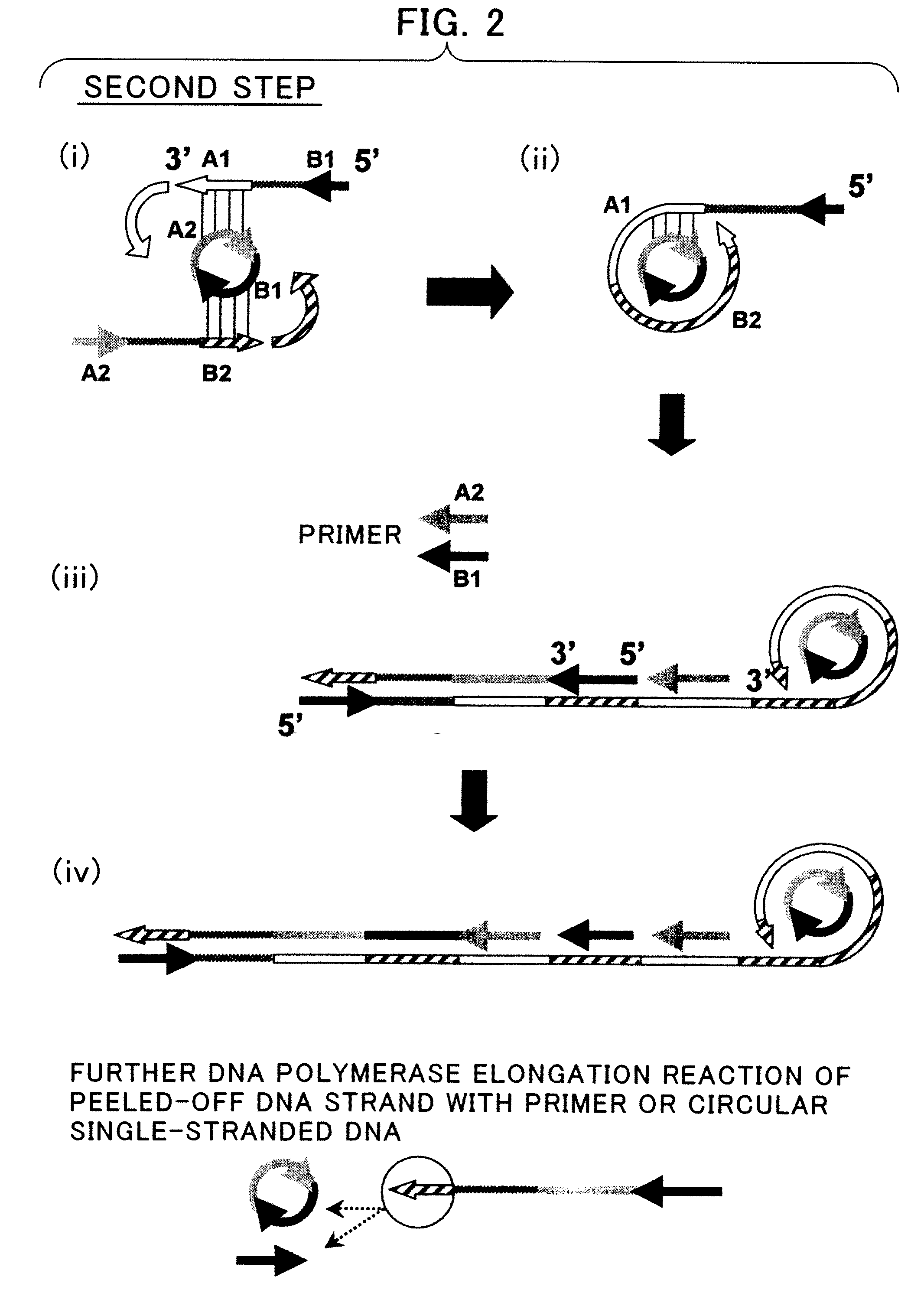Nucleic Acid Amplification Method
a nucleic acid and amplification technology, applied in the field of can solve the problems of detection sensitivity, design and operation of detection methods, instruments for controlling the temperature cycle, etc., and achieve the effect of rapid and clear detection of target genes, simple and rapid detection, and new and effective nucleic acid amplification methods
- Summary
- Abstract
- Description
- Claims
- Application Information
AI Technical Summary
Benefits of technology
Problems solved by technology
Method used
Image
Examples
example 1
Target Preparation Method
[0115]Enzyme products and kit products described below are used in accordance with the respective manuals unless otherwise specifically stated.
[0116]After being treated with a restriction enzyme Dral (Takara Bio Inc.), pUC19 (Takara Bio Inc.) was subjected to electrophoresis (100 V, 50 minutes) by using 1.2% TAE electrophoresis gel in Mupid-ex (Advance Co., Ltd.), which is an electrophoresis chamber.
[0117]Thereafter, staining with a nucleic acid staining reagent SYBR Greenl (manufactured by CAMBREX) was performed, a target DNA fragment (approximately 2 kb) was cut out from the gel and subjected to collection using a DNA extraction kit, NucleoSpin Extract Kit (MACHEREY-NAGEL Inc.), and a target preparation solution (10 mmol / l) was obtained.
Synthesis of a Circular Single-Stranded DNA
[0118]Primers used for synthesis of a circular single-stranded DNA are shown in Table 1. The 5′ end of 43C is phosphorylated, and Bind has been subjected to cartridge purification ...
example 2
Specific Gene Amplification
[0132]Specific gene amplification was performed by using a circular single-stranded DNA preparation solution prepared in a similar manner as that in Example 1.
[0133]Primers used for gene detection are shown in Table 4. All were subjected to HPLC purification (manufactured by Invitrogen Co.).
TABLE 4Primer sequences used for gene detectionNameSequence (5′ to 3′)Forward-inCGACGTTGTAAAACGACGGCForward-outACGCCAGGGTTTTCCCAGTCReverse-inCACACAGGAAACAGCTATGACReverse-outTGGAATTGTGAGCGGATAAC
[0134]In a gene detection reaction, the followings were used.
[0135]Enzyme: Bst DNA polymerase (manufactured by New England Biolabs Incorporation) 4 U / 25 μl
[0136]Target: target preparation solution 0.5 μl / 25 μl
[0137]λ genome: λ genome (Takara Bio Inc.) 0.5 ng / μl
(Reaction Buffer Composition)
[0138]1 / 10 volume a buffer provided with Bst DNA polymerase
1 μmol / l primers in Table 4 (Forward-in, Reverse-in)
0.2 μmol / l primers in Table 4 (Forward-out, Reverse-out)
0.5 mmol / l each dNTP
1 μmol / l...
example 3
Synthesis of Circular Single-Stranded DNA
[0143]The two kinds of polynucleotides in Table 1 (43C: 60 μmol / l, Bind: 3 μmol / l) and a recombinant thermostable DNA ligase manufactured by Wako Pure Chemical Industries, Ltd. (1.25 μl) were mixed to a total of 25 μl, and a reaction was performed under conditions shown below. In addition, a reaction buffer provided with the thermostable DNA ligase was used. The final compositions in the mixed solution are the buffer (2.5 μl / 25 μl) provided with the thermostable ligase (1.25 μl / 25 μl) and the two kinds of polynucleotides in Table 1 (43C: 60 μmol / l, Bind: 3 μmol / l).
[0144]The mixture was subjected to an enzymatic reaction at the same temperature condition as in [Synthesis of circular single-stranded DNA] in Example 1, subjected to ethanol precipitation in the same manner, and dissolved in 30 μl of TE buffer to obtain a circular single-stranded DNA preparation solution.
Check of Synthesis of Circular Single-Stranded DNA
[0145]Synthesis of a circul...
PUM
| Property | Measurement | Unit |
|---|---|---|
| molar ratio | aaaaa | aaaaa |
| temperature | aaaaa | aaaaa |
| temperature | aaaaa | aaaaa |
Abstract
Description
Claims
Application Information
 Login to View More
Login to View More - R&D
- Intellectual Property
- Life Sciences
- Materials
- Tech Scout
- Unparalleled Data Quality
- Higher Quality Content
- 60% Fewer Hallucinations
Browse by: Latest US Patents, China's latest patents, Technical Efficacy Thesaurus, Application Domain, Technology Topic, Popular Technical Reports.
© 2025 PatSnap. All rights reserved.Legal|Privacy policy|Modern Slavery Act Transparency Statement|Sitemap|About US| Contact US: help@patsnap.com



